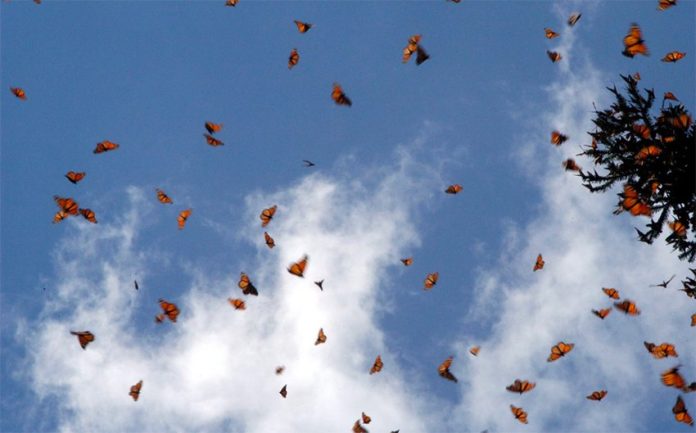The first monarch butterflies of the annual winter migration from the United States and Canada have arrived in the forest sanctuaries of central Mexico.
The Natural Protected Areas Commission (Conanp) said in a statement that the butterflies were “crossing the sky above the . . . Chincua and El Rosario sanctuaries in Michoacán and the Cerro Pelón and Piedra Herada sanctuaries in México state” yesterday.
“. . . They are exploring the territory to determine the best places to establish their colonies during the winter,” the commission explained, adding that it will announce soon when sanctuaries will be opened to visitors.
If weather conditions are favorable, Conanp said, most butterflies should reach the sanctuaries during the next two weeks but it won’t be until the end of November that the entire migratory cohort has arrived.
It added that the arrival of the first monarch butterflies was delayed due to the weather conditions on their route through the United States and Mexico that limited the distance they could fly each day.
Those conditions forced the butterflies to take shelter in different parts of the Sierra Madre Occidental to wait for better weather, Conanp said.
The monarchs started their approximately 4,500-kilometer journey in the south of Canada in August.
Scientists have discovered that the black and gold insects use a kind of internal solar compass to guide them on their journey, during which four or five generations of butterflies are born and die.
During late October and the first week of this month thousands of the species have been observed in Mexico by volunteer butterfly spotters participating in the Correo Real (Royal Mail) program.
The spotters record and report the location of the butterflies to Conanp.
A new digital app called MonarcaMX enables citizens to record a variety of data about the butterflies they see including location, date, time and what they were doing when they were spotted — flying, feeding or resting.
Thanks to citizen reports, it was established that the first group of monarchs crossed the United States-Mexico border on October 20.
However, due to rain and cold, it was another 10 days before they were observed flying over the Sierra de Arteaga in Coahuila and the municipality of Linares in Nuevo León.
During the first days of November, thousands of monarchs were seen flying over Ciudad Victoria, Tamaulipas, according to state authorities, while yet more reached states farther south including San Luis Potosí and Guanajuato.
More than 1,000 volunteer spotters in Guanajuato are hoping to observe at least 3,000 monarch butterflies flying across the state this year.
In Tamaulipas, the state’s Parks and Biodiversity Commission has implemented a conservation program for the monarch butterfly to ensure that its food sources are protected.
By providing incentives to farmers, the program seeks to ensure that tithonia plants, a sunflower native to Mexico, are not removed from cornfields.
“[The flower] is a very important food source during the monarch butterfly migration . . . its nectar is very rich in nutrients for the butterfly,” said commission director Carlos Garza.
Other initiatives aimed at helping the butterflies reach their final destination, such as the planting of 67 gardens in México state where the insects can rest and feed, have also been implemented in recent years.
Yet the number of monarchs that traveled to Mexico last year for the winter declined for the second consecutive season, according to a report released earlier this year.
Extreme weather and the increased use of herbicides in the United States, which reduces the amount of milkweed — a food source for the monarch butterflies, were cited as possible reasons for the decrease in arrivals.
Source: Milenio (sp)
